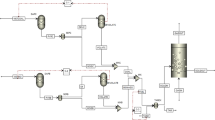The non-catalytic hydrovisbreaking of straight-run mazut residue in an upflow reactor filled with inert turbulizer-packing having a cellular structure and a free volume of about 65% was investigated. Feedstock conversion of 55.1 % was obtained under moderate conditions for such a process (temperature 450°C, hydrogen pressure 5 MPa). The conversion of the non-volatile residue, boiling above 540°C, amounted to 90 % with 96 % demetallization and up to 76% conversion of asphaltenes and tars.. The main product of the hydrovisbreaking process was a kerosene—gasoil fraction with a yield of 43.6%. The distillate products of hydrovisbreaking were similar in quality to the distillates of a slow coking process, except for the lower sulfur content and the complete absence of silicon. The unconverted residue obtained after removal of the light distillates at atmospheric pressure had low viscosity and a low pour point. It can be used as feedstock in hydro purification for marine fuel production.


Similar content being viewed by others
References
Global Energy Statistical Yearbook 2019, Crude oil production. https://yearbook. enerdata. net/crude-oillworld-production-statitistics. html, 2020 ().
D. Davudov, R. G. Moghanloo, J. Petrol. Sci. Eng., 156, 623-632 (2017).
Kh. Kh. Akhmadova, Z. A. Abdulmedgidova, Kh. M. Kadiev, et al, Nejlegazovoe Delo, 2,103-113 (2011).
A. S. Bakshi, I. H. Lutz, Oil Gas Journal, 85, 84-87 (1987).
H. Tominaga, S. Itoh, M. Yashiro, Bulletin of the Japan Petroleum Institute, 19, 50-55 (1977).
E. M. Manapov, A. F. Ishkil’din, A. F. Akhmetov, Chem. Tech. Fuels Oil, 33, 251-253 (1997).
R. Galiasso, J. A. Salazar, R. Blanco, et al, J. Jpn. Petrol. Inst., 28, 54-62 (1985).
International maritime organization, Sulphur 2020 - cutting sulphur oxide emissions. http://www. imo. org/en/MediaCentre/HotTopics/Pages/Sulphur (2020). aspx, 2020 (accessed 22 April, 2020).
M. J. Kaiser, A. de Klerk, J. H. Gary, et al., Petroleum Refining: Technology, Economics, and Markets, sixth ed, CRC Press, Boca Raton (2019).
M. F. Menoufy, H. S. Ahmed, M. A. Betiha, et al, Fuel, 119, 106-110 (2014).
J. Ancheyta, Modeling and Simulation of Catalytic Reactors for Petroleum Refining, John Wiley & Sons Inc., NJ (2011), pp. 43-44.
L. O. Aleman-Vazquez, P. Torres-Mancera, J. Ancheyta, et al. Energ. Fuel, 30, 9050-9060 (2016).
US Patent 9243193.
J. G Speight, Sci. Iran, 19, 569-573 (2019).
R. N. Magomedov, A. Z. Popova, T. A. Maryutina, et al, Pet. Chem., 55, 423-443 (2015).
M. -G Yang, I. Nakamura, K. Fujimoto, Catal. Today, 43, 273-280 (1998).
Y. Miki, J. Catal., 83, 371-383 (1983).
US Patent 4005006.
RF Patent 2377224.
R. R. Vezirov, Chem. Technol. Fuels Oils, 46, 367-374 (2011).
V. B. Koptenarmusov, A. L. Katkov, E. I. Malov, et al, Nefteperera. Neftekhim, 3, 7-15 (2017).
RF Patent 7427350.
A. Del Bianco, G. Garuti, C. Pirovano, et al, Fuel, 74, 756-760 (1995).
M. B. Vermeire, Everything you need to know about marine fuels, published by Chevron Global Marine Products (2012).
Author information
Authors and Affiliations
Corresponding author
Additional information
Translated from Khimiya i Tekhnologiya Topliv i Masel, No. 3, pp. 9 — 13, May — June, 2020.
Rights and permissions
About this article
Cite this article
Boldushevskii, R.E., Yurmukhametova, R.F., Antonov, S.A. et al. Hydrovisbreaking of Mazut Heavy Oil on Inert Packing with Cellular Structure. Chem Technol Fuels Oils 56, 333–340 (2020). https://doi.org/10.1007/s10553-020-01142-6
Published:
Issue Date:
DOI: https://doi.org/10.1007/s10553-020-01142-6




